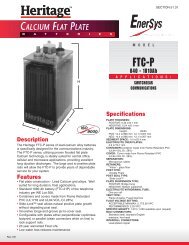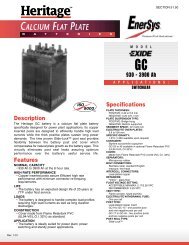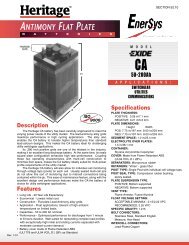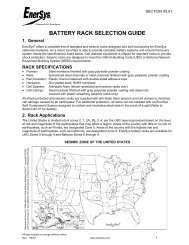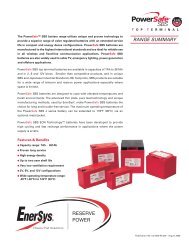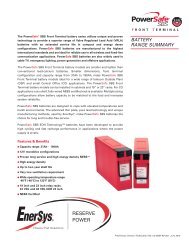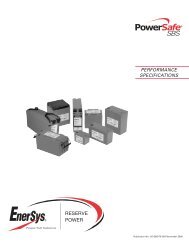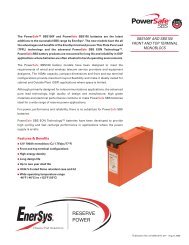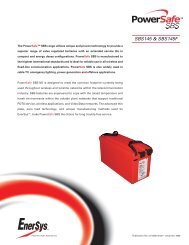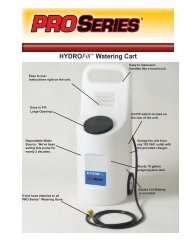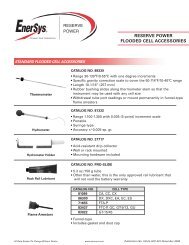PowerSafe V Product Guide new - EnerSys
PowerSafe V Product Guide new - EnerSys
PowerSafe V Product Guide new - EnerSys
Create successful ePaper yourself
Turn your PDF publications into a flip-book with our unique Google optimized e-Paper software.
Charging<br />
Voltage Setting<br />
SBS are designed for continuous float operation on constant<br />
voltage chargers. Constant voltage charging is the safest, most<br />
efficient and recommended method of charging VRLA<br />
batteries.<br />
The recommended float voltage setting is 2.27 volts per cell<br />
at 25°C/77°F. Therefore the system voltage setting equals<br />
the number of cells in series x 2.27Vpc.<br />
Battery life and charging characteristics are affected by<br />
temperature. Optimum battery life will be achieved when the<br />
battery is operating between 20°C/68°F to 25°C/77°F.<br />
Battery life is reduced by 50% for every 10°C/18°F increase<br />
in temperature. Float voltage compensation reduces the<br />
charging current as battery temperature increases, and<br />
partially negates the adverse effect of high temperature.<br />
The recommended float voltage temperature compensation<br />
is:<br />
■ 2.27Vpc + 0.004 mV per cell per °C/1.8°F below 25°C/77°F<br />
■ 2.27Vpc – 0.004 mV per cell per °C/1.8°F above 25°C/77°F<br />
Float volts per cell<br />
2.32<br />
2.31<br />
2.30<br />
2.29<br />
2.28<br />
2.27<br />
2.26<br />
2.25<br />
2.24<br />
2.23<br />
2.22<br />
2.21<br />
2.20<br />
Figure 3<br />
Float Voltage Temperature Correction<br />
15 16 17 18 19 20 21 22 23 24 25 26 27 28 29 30 31 32 33 34 35 36 37 38 39 40<br />
The battery and ambient temperatures can be significantly<br />
different. Batteries have a large thermal mass, and there is a<br />
substantial time lag between changes in ambient and battery<br />
temperature.<br />
Thermal sensors must register battery temperature, not<br />
ambient temperature. As a rule, sensors should be placed in<br />
the following positions:<br />
www.enersysinc.com<br />
Minimum<br />
Temperature °C<br />
Recommended Minimum<br />
■ Front terminal models - in the centre of the side wall of a<br />
bloc, in the middle of the string<br />
■ Top terminal models - attached by a ring terminal to the<br />
terminal of a bloc in the middle of a string<br />
Sensors on the side of blocs should be insulated from<br />
ambient temperature.<br />
Temperature compensation is capped at 40°C/104°F, at<br />
higher temperature the compensated voltage approaches the<br />
battery open circuit voltage and there would be insufficient<br />
over voltage to keep the battery in a fully charged condition.<br />
Charging Current<br />
There is no limit on the charging current provided the float<br />
voltage is set at the recommended value as the battery itself<br />
will regulate the current, accepting only as much as is<br />
required to reach float voltage.<br />
Recharge time is a function of the charging current.<br />
To recharge in an acceptable time it is recommended that the<br />
current output of the charger should be equal to the standing<br />
load plus 0.1C8 to 0.4C8.<br />
Typical recharge times are shown in Figure 4.<br />
Ah RETURNED AS % OF DISCHARGED<br />
RECHARGE PROFILE @ 2.27Vpc & C/10 AMPS<br />
RECHARGED FOLLOWING A 10 HOUR RATED DISCHARGE<br />
110<br />
100<br />
90<br />
80<br />
70<br />
10% DCHD 50% DCHD<br />
80% DCHD 100% DCHD<br />
60<br />
50<br />
40<br />
30<br />
20<br />
10<br />
0<br />
30% DCHD<br />
0 1 2 3 4 5 6 7 8 9 10 11 12<br />
TIME (HRS)<br />
Figure 4<br />
Publication No: EN-SBS-PG-001 February 2003<br />
19




